Samsung QN95C
Product Name: Samsung QN95C
Product Description: 2023 4K Neo QLED TV
-
Build Quality - 9.2/10
9.2/10
-
Image & Audio - 9.2/10
9.2/10
-
Connectivity - 9.5/10
9.5/10
-
OS & Smart Features - 9.4/10
9.4/10
-
Price / Quality - 8.6/10
8.6/10
Summary
Reviewed at $3,299.00 (65″)
Pros
- Great SDR & HDR brightness
- Very little blooming
- Very good image accuracy
- Full of gaming features
Cons
- No Dolby Vision
- No DTS or DTS:X
- Some stuttering is visible
- No 55″ in the US market
Cheapest Places to Buy :
*We are a reader-supported website. When you buy through links on our site, we may earn a small affiliate commission at no extra cost to you. Home Media Entertainment does not accept money for reviews.*
We have tested a lot of Samsung’s 2023 TVs lately but one model that was still elusive to us was their flagship mini LED. Finally we were able to get our hands on it, so in our Samsung QN95C review we will put it to the test to see if it is worthy of its naming.
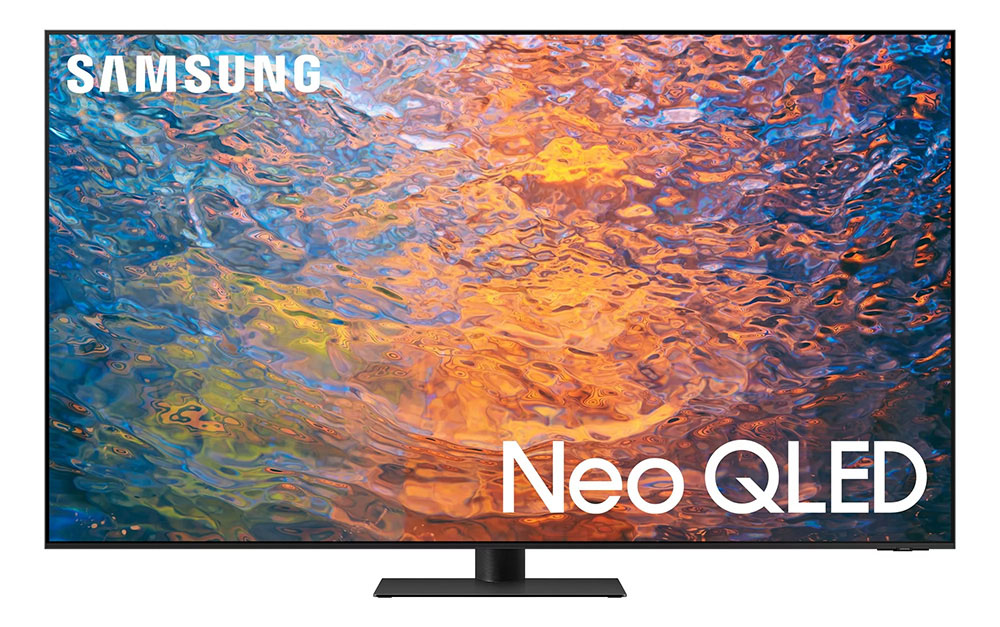
The QN95C supposedly replaces the 2022 Samsung QN95B. There are a few notable changes to be found between these two models and Samsung seems to have tried to improve some areas where they thought needed more attention. Did they manage to succeed?
Before we answer the above question let’s go over the specs real quick. The TV comes with a VA panel that can do up to 144Hz, it uses Samsung’s top Neural Quantum Processor 4K, supports HDR10+ and for sound uses the Object Tracking Sound+ (OTS+) audio system with Dolby Atmos. It also comes with four HDMI 2.1 ports and uses the latest Tizen 2023 platform.
The specs above do not reveal any meaningful differences, other than the updated software. What other changes Samsung did this year? And were all of them in the right direction? Let’s start our analysis to find out.
Design
It seems that Samsung cannot make up their minds concerning their proprietary One Connect Box. After its initial appearance we have seen them taking it out, bringing it back and then ignoring it again in the last few years.
All of this back and forth has an obvious impact to the TV’s design. As they have to change the back that incorporates the connectivity ports. And this is what happened to the QN95C.
The most notable change compared to the QN95B is that once again they decided to take out the One Connect Box. And although the QN95C does have many of the design touches we saw in the QN95B, some fundamental changes had to be made.
But overall build quality is really good. And Samsung made sure its premium design is felt upon looking at it. The whole unit feels very sturdy and nicely constructed. We didn’t notice any defects during our testing.
Measurements
Thickness of the TV is about 0.98″ (2.5 cm) which makes it slightly thicker than its predecessor. But this was to be expected with all the connections now placed on the main body. But the difference is not huge. And Samsung made sure to create a very nice and slim flagship overall.
Its borders were measured 0.30″ (0.8mm) which is just about what you should expect from a premium design like this.
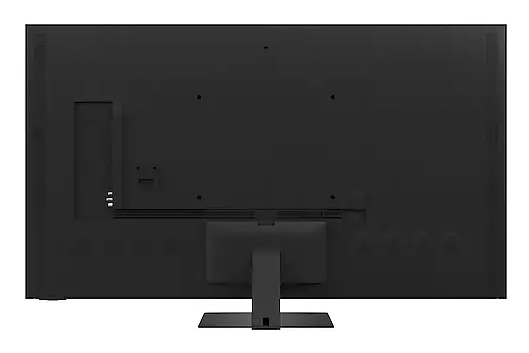
Back Side
The back side of the TV is covered by a plastic panel that in true Samsung fashion has a brushed texture look on it. Just like the QN95B there are four woofers on each side that are exposed. Along with vertical perforated grilles that occupy each side that are part of the OTS+ audio system.
This time instead of a single port at the center, all connections are placed on the left side. These are placed in a special inset with grooves below it to drive the cables through the central stand. Lastly the VESA mount holes are found in the center as always.
Stand
With the omission of the One Connect Box Samsung had to change the stand design also. It is still a center-mounted design which is good for small furniture but make sure that the TV is in a safe position as bigger sizes will surely wobble a bit more that what we would like.
The stand provides some additional cable management as there are grooves at the back of it. This way you can keep your cables hidden and out of sight.
We measured the space between the screen and our furniture and it was just a bit more that 3″. Which should be plenty for almost all available soundbars out there. So you shouldn’t worry if it fits there in case you are considering one.

Remote
The remote included in the QN95C is exactly the same one we saw in many Samsung TVs this year. Like the Samsung S95C and Samsung QN90C. It is very similar to the 2022 remote but there are some minor design changes. The new remote lost one button at the top and it has a slightly different design with more round corners in all sides.
It is still small and uses very few buttons as it relies on the TV’s UI for most of its functions. It comes with a rechargeable battery that can be charged either through a USB-C cable or from its solar equipped back side.
The new remote is every bit as functional and practical as it was last year. To be honest we are not very thrilled by the minor design change but this comes down to personal taste.
Video Quality
Processor technology used
In 2023 many of Samsung’s top tier TVs got an upgraded processor, now called Neural Quantum Processor 4K. This processor seems to be similar in capabilities with the processor that was used in the 8K TVs of 2022. In fact this is the same chip that the top-tier S95C is using this year.
What we do know is that this processor uses up to 20 different neural network models. Each of them is trained in AI upscaling and deep learning technology. As a result the processor can optimize picture quality to 4K picture output regardless of the input quality.
Also its Real Depth Enhancer feature automatically separates objects in the content from the background. This creates a 3D like depth in order to make the image even more immersive.
Another feature that finds its way form previous years is Adaptive Picture. This can analyze the light conditions in your room and can calibrate the picture accordingly in order to provide you the best image quality for your specific situation.

Resolution and Up-scaling
As always first comes our upscaling testing. We run a few videos in different resolutions ranging from ultra low quality ones, some 480p DVDs, some in 720p and obviously 1080p resolutions. We tried broadcasting signals, streaming content and discs to have a better, all around idea of the TV’s capabilities.
Low quality content looked good but not great, especially considering this is a flagship unit. Macro-blocking was obvious in a lot of scenes and the TV failed to retain some of the finer details of the original content. It is not as bad as you may think. But considering this is Samsung’s top mini LED TV we were hoping for something better.
With lower resolution videos the QN95C upscaling capabilities were really good. The final 4K images retained a lot of details from the source content. Text also appeared clear enough in various sizes that we tested.
Audio Processing
For audio the TV comes with Object Tracking Sound+ (OTS+) system. Along with it we get various audio features like Adaptive Sound+ and Active Voice Amplifier (AVA). But more on these in our dedicated audio section below.
Overall the TV comes with the same audio features we saw in the QN95B and the new QN90C.
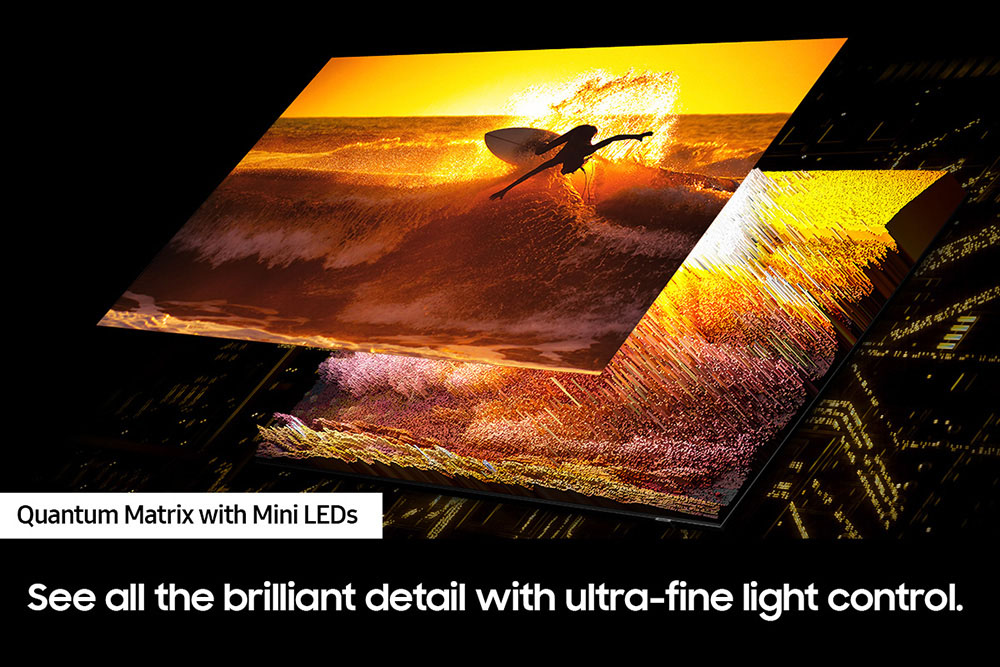
Lighting technology used
The QN95C is using a mini LED backlight system which is precisely controlled by Quantum Matrix Technology. The major advantage of Quantum Mini LED is that it only has 1/40 the height of a conventional LED.
Instead of using a lens to disperse light, and a package to fix the LED in place, the Quantum Mini LED has incredibly thin micro layers filled with many more LEDs. This way Quantum Matrix Technology has much better and more precise control of the densely packed LEDs. This prevents what was the most obvious disadvantage of previous LCD backlight systems, blooming.
Keep in mind that mini LED technology is vastly superior to any other LCD backlight system so far. But it cannot completely erase the blooming problem that plagues LED LCD TVs. The number of zones used along with how efficient the dimming algorithms are determine how good it can be.
Number of Dimming Zones
There is no 55″ of the QN95C in the US market so we tested the 65″ this time. Keep in mind that in the UK and other European markets Samsung sells a 55″ QN95C. But we cannot be sure if it is similar to the North American QN95C.
As for the 65″, this seems to use a total of 1,344 dimming zones. Obviously this number scales according to the TV size but we cannot be sure of exact numbers for all the other models.

Blooming & Zones Transitioning
The TV is handling blooming a bit different from the QN95B. In most cases it managed to show less blooming than its predecessor which surely is an improvement, as the QN95B was already very good.
But there were a few scenes where the TV seemed to fair a bit worse than expected. When large portions of the screen displayed some bright highlights the light would spread more than it should. This created a blooming effect that would cover most of the scene.
The above effect was not something we observed very often. And it seems that was happening in very specific situations. So while overall we could admit that the QN95C improved in this area, it is not without a few downsides.
Zones transitioning was good but not great. As fast moving highlights would reveal the relatively slow response time of the dimming zones. As a result the front part of the moving object may look darker until the zone can get into full brightness. On the other hand the zones do not transition to black very fast either. This creates a ghosting effect that does not look very good.
Most of the time this is not something you will pay attention to. With real world content we hardly noticed it. It was mostly obvious using test patterns and in some very specific scenes. So this is not something you should be worried about very much.
SDR and HDR Brightness
Next we will be looking at the brightness of the unit. In terms of settings we used the usual as we do in all Samsung models. We used the Movie mode and Warm 2 color tone along with Local Dimming set to High.
First test is the SDR brightness over a 10% window and the number we got was 1,668 nits which is excellent. With such high brightness output the QN95C will not have trouble even in the brightest of rooms.
We then switched to HDR content and in our HDR brightness over a 10% window test we measured 1,750 nits. Again the TV performed admirably. It can pump enough brightness to make any kind of HDR content look amazing.
What is obvious from the above numbers is that the QN95C is slightly less bright than its 2022 counterpart. The difference is not huge, and the QN95C still has incredible brightness output. But for comparison’s shake the QN95B did a bit better here.

Automatic Brightness Limiter (ABL)
As with most TVs, the QN95C comes with an Automatic Brightness Limiter (ABL). This lowers the overall brightness of the screen when large parts of it become very bright for a long period of time. This may not be very obvious when watching a movie for example. But is more obvious with bright static images, or if you use the TV as a computer monitor.
The ABL on the QN95C did kick in after setting a specific bright image for a long time. You don’t have to worry about this in normal viewing and it’s mostly notable when you compare images. Also the TV’s brightness is high enough that even when the ABL kicks in, it is bright enough to preserve most highlights.
Compared to the QN95B, the ABL on the QN95C was somewhat less aggressive. But this may also have to do with the TV’s overall lower brightness.
EOTF Tracking
Brightness levels were extremely close to the EOTF reference values up to its relatively sharp roll-off point. Although the tracking is not perfect it is a close one. The TV followed the entire tracking slightly below the desired levels but this was very subtle.
As usual, for the QN95C to follow the curve accurately you have to use its Static tone mapping setting as using the Active option will increase highlight intensity which makes the image less accurate.

Contrast Performance
Let’s talk about contrast next. The QN95C uses a VA panel, which means it has very good contrast overall. The TV comes with Samsung’s Ultra Viewing Angle technology, which unfortunately has a negative impact on its native contrast. But due to the inclusion of its local dimming feature the TV is capable of displaying really deep blacks no matter the content.
Viewing angles
As for its viewing angles the TV behaved almost the same as the 2022 models along with many other flagship units from Samsung. The QN95C is equipped with a VA panel which in general doesn’t mean good things when it comes to viewing angles.
In order to combat this Samsung has used what they call Ultra Viewing Angle which is a technology that minimizes the light leakage by focusing the light on the right direction and as a result we can get better image results at far greater angles than without it.
Also a glossy coating called Anti-Glare technology is used to minimize the reflections from strong lights.
The QN95C did perform better than most TVs that don’t use this extra layer on the panel. It cannot reach the viewing angles we see in OLED and QD-OLED models so don’t expect anything similar.
But the combination of the Ultra Wide Angle and Anti-Glare technologies allows for a maximum of 40 degrees of angle from the sweet center spot which is the most these LED LCD TVs can do nowadays.

HDR support
HDR formats is another area where things haven’t changed much. Most brands decided a few years ago about this and we haven’t seen any change since then.
As such we get the most basic HDR10 that is required for 4K UHD playback. There is also HLG that is used mainly for broadcasting. And lastly the newer HDR10+ which is the most advanced HDR protocol. This uses dynamic metadata in order to provide the best image quality on a frame by frame basis, similar to what Dolby Vision is doing.
In the QN95C we also find HDR10+ Adaptive and HDR10+ Gaming. HDR10+ Adaptive uses its AI engine to analyze the viewing environment. This includes the lighting, brightness and even reflections using the sensors equipped on the TV.
The results are then incorporated into the dynamic metadata. After going through four further steps, the brightness and contrast of a scene are optimized. This way you can view HDR10+ movies and television programs in various environments at home.
As we already mentioned above, the QN95C comes with an HDR Tone Mapping setting. You can set this to either Static or Active with Static being more accurate. Active will increase highlight intensity but makes the image less natural.
Unfortunately, Samsung still refuses to allow Dolby Vision in their TVs and stay firm behind their own HDR10+. A big disappointment, and we have no hopes this to change any time soon.
Color coverage
The QN95C, being in essence a QLED, uses Samsung’s special Quantum Dot layer. With this the TV is capable of displaying more vivid and lifelike colors. Samsung claims 100% coverage of the DCI-P3 color space for all of their QLED and Neo QLED series. But you should never take these numbers literally as they are mostly used for marketing purposes. Real numbers usually deviate a lot from these claims.
In our case we measured the TV to have about 91% coverage of the DCI-P3 color space which is great. On the wider REC.2020 color space we got a coverage of 68% which again is very good.
The numbers are not very different from what we measured in the QN95B. So no major changes here.

DeltaE Errors
Before calibration the TV had good color accuracy but not without a few noticeable problems. Most colors managed to stay under the DeltaE limit of three but there were a couple of exceptions. Gamma was higher than its target value. White balance needed correction while color temperature was warmer than it should.
After calibration we managed to improve a lot of the above mentioned problems but not entirely. White balance and gamma were much better but still not perfect. Color temperature on the other hand was spot on. As for the colors we managed to bring all of them under the desired target level of three.
The TV may not have the best out of the box accuracy but we can describe it as acceptable. Certainly we have seen far worse here. So in case you are a casual user that wants to use only default settings, the TV has plenty to give you. But obviously if you want to get the most out of it be prepared to spend the time needed to calibrate it properly.
Color Gradients
Color gradients were amazing with almost no visible banding at all. Some very minor banding was visible, but this was so subtle and hard to see it is not even worth mentioning.
As always there is a Noise Reduction function that can reduce this effect even further. But you are going to lose some fine detail if you use it, as is always the case with this feature. And to be honest, with the QN95C you are not going to need it.

Panel Uniformity
Panel uniformity of the QN95C is a mixed bag. Grey uniformity proved to be average at best. The panel had noticeable dirty screen effect while we also saw vignetting, which is an effect that shows darker corners than the center of the screen.
Black uniformity, on the other hand, was way better. We noticed a bit of clouding with the local dimming set to Low. But with Local Dimming set to high the whole screen was almost perfect.
Motion performance
Next we will test the TV’s motion performance. And from the looks of it the QN95C is not all that different from some other Samsung flagships.
The QN95C comes with a 144Hz panel along with a backlight dimming frequency of 960Hz. This is exactly the configuration we saw in the QN90C recently. Such a high frequency ensures that flickering is completely invisible but this also depends on the picture mode. Because in some of them the frequency drops to 120 Hz (like Filmmaker or Standard modes) while in others it remains at 960Hz (Movie mode).
In terms of motion the TV did good with very little blur in fast action scenes. This is obviously a result of the QN95C’s fast response times. On the other hand we did notice some stutter with low framerate content that you can fix only by enabling motion interpolation.
The TV can also remove judder either from 24p or 60p content, which is great for any kind of content.

Motion Interpolation
Motion interpolation could not be missing and is named Motion Xcelerator Turbo Pro. This is different from the Motion Xcelerator Turbo+ in the QN90C because the QN95C can do up to 144Hz while the QN90C does not (only the 43″ and 50″ support 144Hz on that model).
The QN95C was capable of removing judder and stutter but as usual artifacts would become visible in more demanding scenes. We also noticed that, in very heavy scenes, the TV would stop interpolating which resulted in some very obvious framerate differences.
This feature is enabled in the same way as with all other Samsung models. You will find it in the Picture Clarity settings, in the menu, and by adjusting the two sliders for blur or judder.
Keep in mind that very high values in the sliders and the “Soap Opera Effect” will appear. So if you want to improve motion keep minimal values in these two sliders. A value of 1 or 2 can smooth motion enough without affecting the quality much.
Black Frame Insertion (BFI)
Black Frame Insertion (BFI) is also available as usual which can be enabled in the menu with the LED Clear Motion option. BFI is a technique that inserts a black frame in between two individual frames in order to smooth out motion.
Although the end result is very good, it has a couple of side effects. First due to the black frames, brightness takes a visible hit. Thankfully the QN95C is bright enough so taking a small brightness hit is not such a big deal.
The second is that BFI can work only with 60Hz. It doesn’t work with 120Hz so this means you cannot use it for 4K@120Hz gaming.

Overall Motion Impressions
Overall the TV behaved very similar to all other top tier Samsung TVs we tested. Compared to the QN95B, the QN95C did not show any major differences. Motion was as good as expected and motion interpolation worked as it should, to a certain extent. The only difference we spotted was that this year BFI worked only with 60Hz content.
Input lag Measurements
Next we will test the TV’s input lag performance.
According to our measurements the QN95C had an average of 11.5ms input lag in both 1080p and 4K resolutions at 60Hz. These numbers are more or less what we expected to see. At 120Hz we measured 7.0ms in both 1080p and 4K resolutions which is as good as it gets. We also measured the TV’s 144Hz capabilities and this was measured at 5.6ms in 1080p and 4K.
Keep in mind that the above numbers only appear with Game mode enabled. Outside that the input lag will greatly increase to around 85ms, on average, which is a bit high for online gaming. But it can still be acceptable for slow paced, offline games.
Other Gaming Features
We should also not forget to mention that the TV supports Auto Low Latency Mode (ALLM). This can be used with any devices that support that like the PS5 and Xbox consoles and can greatly benefit users.
As with all Samsung TVs, HGiG Mode is not missing either. This is HDR Gaming Interest Group’s technology that ensures you enjoy HDR games the way that their creators and developers intended.
One feature that we got last year through a firmware update was the Samsung Game Hub. Well, this year it is available from the start in many of the 2023 models, including the QN95C. With it you can use various online gaming services, including the Samsung-exclusive Xbox app. But as always the kind of content you will find in the Hub depends on the region you are.
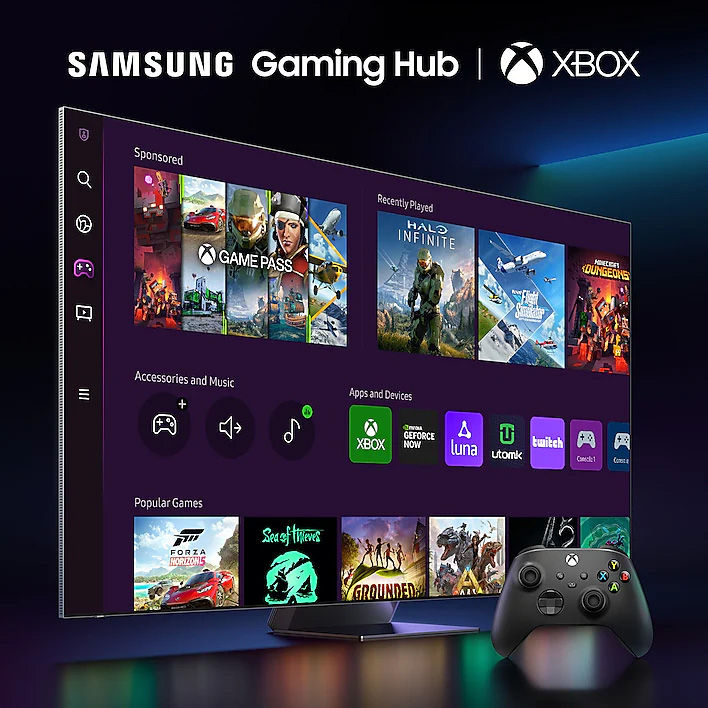
VRR Support
In terms of VRR support the TV supports them all. As such you get HDMI Forum VRR, AMD FreeSync and NVIDIA G-Sync. And you can handle all of them in the new Game Bar 3.0.
Trying Out a Few Games
As we usually do, to get a feel of the TV’s responsiveness we connected both our PS5 and Xbox series X to one of the HDMI 2.1 ports of the QN95C. The games of choice lately are F1 2022 which supports both 60Hz and 120Hz and Dead Space which is a 60Hz game only.
Our time with both games went by without a single problem. We started with Dead Space which is a 60Hz only experience. It slow paced gameplay obviously is more forgiving when it comes to fast response times. So we didn’t notice anything out of order and all our commands registered nicely on screen.
F1 2022 came after and this game actually has a 120Hz mode. We did try that and surely the difference with 60Hz was more than obvious. F1 games require razor sharp reflexes and reaction times and the TV delivered. We didn’t notice any delays and everything was super smooth and instant.
Overall Image Quality Impressions
The 2023 QN95C has many similarities to its predecessor but also a few differences that are worth mentioning. First of all the new model comes with more dimming zones and this is obvious by its better handling of blooming. We also noticed that it has a bit better image accuracy.
On the other hand the QN95B is brighter, even if not by much. In all other categories these two TVs were really close to each other.
Overall we prefer the QN95C. Yes, we do lose some brightness but this is a sacrifice we can accept in order to get a more accurate picture. And since the QN95C is still a very bright TV this sacrifice is not one you should worry about.
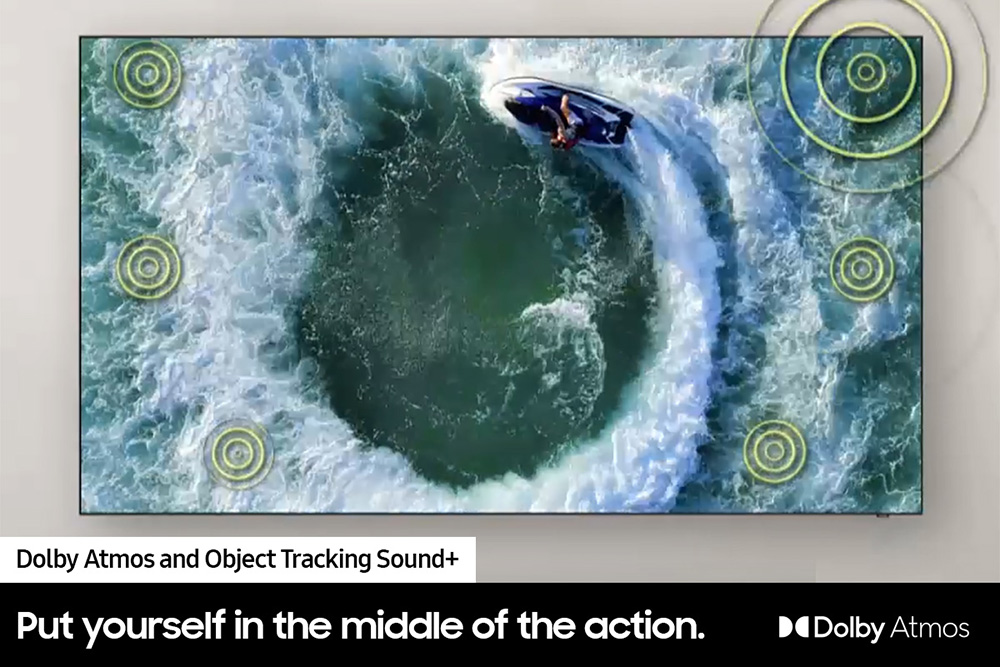
Audio Quality
As most brands, Samsung developed their own audio system to use in many of their top and middle tier models. It is called Object Tracking Sound and as of 2021 there are four variants of this system depending how capable it is. We have the OTS Pro, OTS+, OTS and OTS Lite.
The QN95C got the Object Tracking Sound+ (OTS+) variant, which again is the same as last year.
Audio System – Channels & Power Rating
The Object Tracking Sound+ (OTS+) in the QN95C uses a 4.2.2 channels configuration with 70 watts of power output.
Audio Formats Support
The TV supports Dolby Atmos but don’t let this fool you. The TV, as any Dolby Atmos TV for that matter, cannot create a real Atmos experience. If you want to get the most out of it then you will certainly need a dedicated audio system or at least a good soundbar with surround speakers. Dolby Atmos can pass-through from eARC to some Dolby Atmos soundbar or dedicated sound system in this case.
A feature we saw for the first time last year and makes a comeback is wireless Dolby Atmos transmission. With it you can pass Dolby Atmos sound to a soundbar without the need to connect a HDMI cable. Just keep in mind that the soundbar must support this feature also. Be very careful with the specs as not all Samsung soundbars come with this.
As usual with Samsung, there is no DTS support. As such the TV cannot decode or pass-through DTS or DTS:X audio signals to another device. Samsung made that decision some years ago but with LG bringing it back for some of its premium models there is still hope Samsung will follow.
But for the moment Samsung remains the only TV brand not to support DTS at all.

Audio Features
With the QN95C being Samsung’s flagship mini LED TV, they went ahead and added everything in terms of audio features. So let’s see what is there for you to find.
First we find Adaptive Sound+ with which the TV analyzes the content and for each scene can identify and render the best sound type. This whole process starts by separating and classifying audio input signals. After it pulls out its key characteristics, it renders them to best suit the scene.
We also get Active Voice Amplifier (AVA). By using AVA the TV can detect environmental noise and enhance the voice output of the content you watch for a more pleasant viewing experience.
And obviously with a Samsung TV we could not miss Q-Symphony. This is a feature that you can use to combine the TVs audio system with an appropriate soundbar that supports it.
This year Samsung released Q-Symphony 3.0 and with it the audio can sync and output from both devices for an even more immersive audio experience. Samsung released a whole lineup of soundbars that support this feature in case you are thinking of getting one.
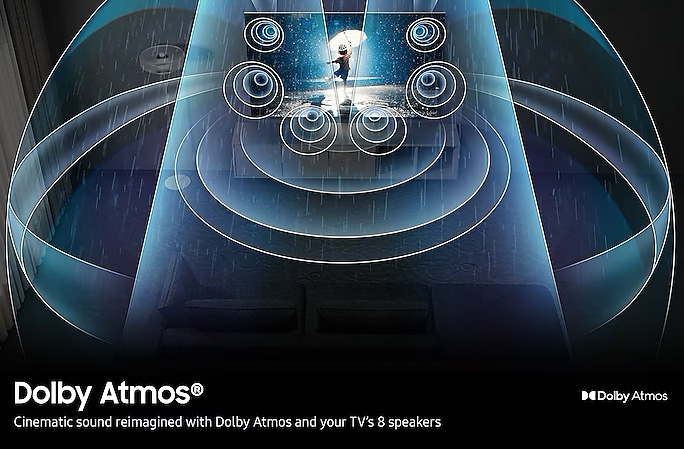
Overall Audio Performance Impressions
This is not the first time we have experienced the OTS+. We had tried it many times before like with the recently released QN90C but also with the QN95B. So we knew more or less what to expect. And in the end this is what we really got.
The TV’s audio system is good enough for most casual content. If you want to use it for broadcasting material, sports or casual TV series viewing it is just fine. Heck, it can be even good for an occasional movie. But if you really want to match the TV’s amazing picture quality to an equally impressive and immersive sound, the OTS+ falls way short.
The sound output was very constraint. There was not much in terms of extension and you will not feel sound coming all around you. Also the overhead layer felt very empty and not particularly defined.
Obviously not everything is bad, after all we said already that for casual usage it is good. The TV can get loud enough. And the dialog is distinct and clear for most content you are not particularly demanding about.
But obviously if you buy such a TV unit you should expect something more from the sound than just the basics that the OTS+ can give you. So keep your expectations at check, or buy a dedicated Dolby Atmos sound system and enjoy a real cinematic experience.
Ports and Connectivity
Samsung is using the exact same layout in many of their TVs for some years now. And the QN95C is no different from the rest.
Starting from the top right we find two USB ports, a single digital optical output, four HDMI ports, an Ethernet port for wired connection to your local network, an Ex-Link port and the usual antenna/cable connector.
HDMI Specifications
From 2022 and onwards Samsung updated the HDMI ports in many of their TV models. So now all of them support the full 48Gbps bandwidth. And this continues into 2023 with the QN95C using four, fully capable HDMI 2.1 ports.
These support all new and old features including 4K@144, ARC, eARC, ALLM, VRR, G-Sync, FreeSync Premium Pro, HFR and HDMI-CEC.
Keep in mind that only Samsung and LG have four fully capable, 48Gbps HDMI 2.1 ports in their TVs. All other brands have only two due to the limitations of the MediaTek HDMI SoC that they are using the last few years. Hopefully the new MediaTek Pentonic variants that will come out soon will change that. But until then if you definitely want four HDMI 2.1 ports, Samsung or LG are your only two choices.
Connectivity Observations
And while we could not be happier with the four HDMI 2.1 ports, the inclusion of a 100Mbps Ethernet port is inexcusable in 2023. We cannot understand why TV manufacturers still insist on not including Gigabit adapters.
Streaming requirements and internet connections have greatly advanced the last few years. This made the 100Mbps limit obsolete a while back. And while most TVs update their WiFi capabilities (some models support WiFi6 this year) the Ethernet adapters are still the same.
Wireless Capabilities
As for its wireless capabilities the Samsung QN95C supports WiFi5 (802.11ac) along with Bluetooth 5.2 which is the same across all Samsung TVs in 2023.
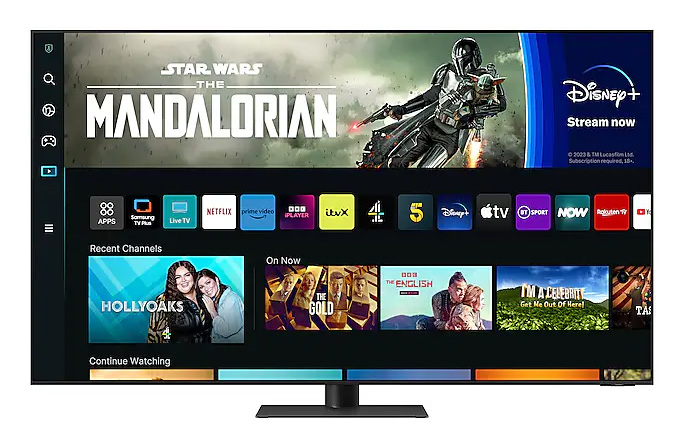
OS, Apps and Features
Samsung updated their OS to the latest 2023 version but this is only a minor upgrade compared to the 2022 version. Almost everything is still the same and this year there are small improvements and additions.
The QN95C is using the same Tizen version as all the other 2023 Samsung TVs. So this part of our review will obviously be similar to what we observed in all our other recent Samsung TV reviews.
Tizen 2023
Being a Samsung TV means that for its OS we find the usual Tizen platform in its 2023 edition. The new Tizen occupies the whole screen instead of being a tile based row at the bottom of the screen, exactly as Google TV and webOS are lately.
It seems that smart TV platforms opt for a more personalized experience and as such the new OS tries to provide you with options that are tailored for your viewing habits. As such you will see personalized ads, recommendations for streaming services and broadcasting channels and even shopping suggestions.
If you have used Tizen before 2022, the new version may feel a bit chaotic at first. This was the same with Google TV and webOS when they changed into a full screen UI and certainly you will need to spend some time with it to get your bearings. But once you get the hung of it, it is easier to navigate than it may seem.
Samsung Smart TV Hub
The new Samsung Smart TV Hub includes different sections and it allows you to navigate easily through all of them. At the left of the screen there is a single column with a few central selections while the rest of the screen use rows with streaming services, apps and other functions and features available.
The new Tizen is not all that different really. Obviously the layout is tailored to Samsung’s needs but in essence it offers the same thing. While navigating through all the settings and menus we didn’t notice any slowdowns or freezes. All apps would open and close relatively fast, even when trying to change between them really fast.
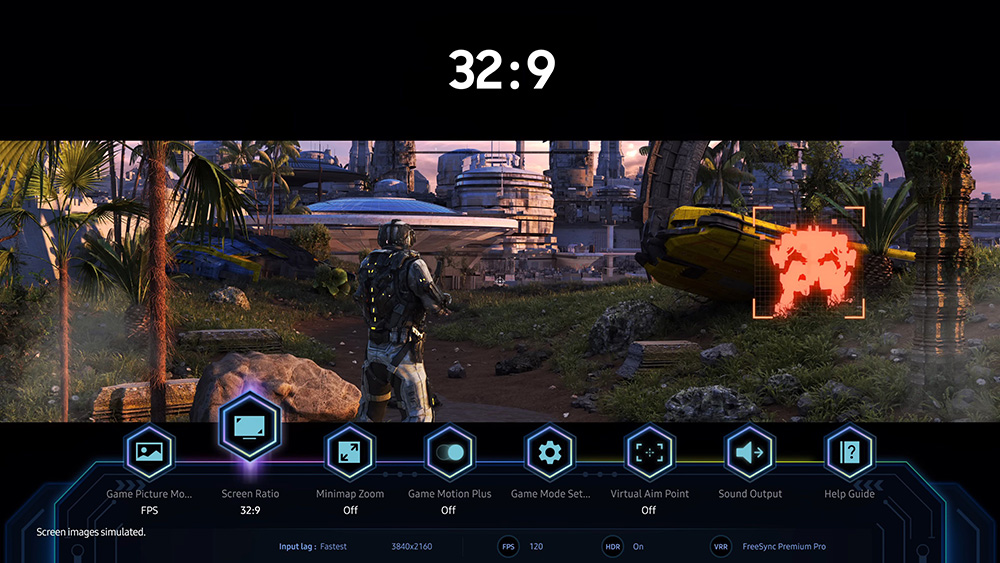
Game Bar 3.0
Let’s go over some of the features we find this year. These are all the same features we saw in our QN90C and S95C reviews, so no real changes here. And the first we will talk about is the Game Bar.
In 2023 this feature is now in its 3.0 version. This is an on-screen menu that lets you make real-time adjustments to screen ratio, input lag check, FPS, HDR, wireless headset settings and more. This can be a really handy feature to gamers as you don’t have to mess with menus every time you want to check on a specific setting. With this quick feature you have everything in front of you with the click of a button.
The new Game Bar 3.0 has a couple 2023 features that were not available before. This is MiniMap sharing and Virtual Aim Point for gaming. And, as we mentioned above, Samsung TVs remain the only ones that include Xbox’s Game Pass.
Streaming Capabilities
When it comes to content the Tizen platform is famous for it’s enormous support from developers. The QN95C offers practically all known services and platforms you can think of. Netflix, Apple TV, Disney Plus, Youtube, Amazon, Hulu, Rakuten, Demand 5 and BBC iPlayer are just a few of the big names available.
There is also Samsung TV plus which offers hundreds of subscription-free channels to choose from. Many of these services can playback in both 4K with HDR like Netflix and Amazon but this really depends on each app and not on the TV itself.
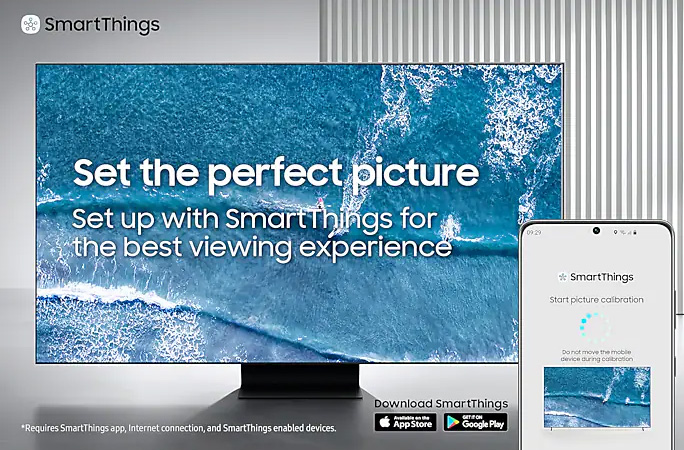
SmartThings Integration
With a Samsung TV, SmartThings integration is a must. With it you can make your TV the central hub of all your smart houses devices. These can be lights, electronic locks, alarms, vacuum robots, thermostats and everything that supports the SmartThings platform.
For 2023 Samsung added Matter and Thread integration meaning you can control such devices from a single app instead of multiple ones and there is no need for an additional dongle as it is built-in the TV itself.
Voice Control
Voice control is another standard feature nowadays. It seems that Samsung is really trying to market their own Bixby service. But even if you are not very fond of that there is Amazon’s Alexa or Google Assistant to choose from.
On the other hand, if you are an Apple guy then don’t get disappointed as there is also Airplay 2 support. And you can even use Siri through it for your voice commands. Unfortunately while Airplay is available HomeKit is not, something that hasn’t really changed lately for Samsung.
Multi-View & Tap-View
Another feature that was introduced some time ago and seems to be a standard now is Multi-View. Although at it’s core this is not something entirely new Samsung took it a step further. Multi-View is basically a more advanced screen mirroring program. But with it instead of just simply projecting the screen from your mobile device on the TV you can choose to have two screens showing both TV content and what your mobile device shows.
In addition to Multi-View there is also Tap View. With it you can mirror your phone on your TV with just a tap to continue enjoying movies, music, and apps on the bigger screen within seconds. Nothing major, but anything that can save even a few seconds of your time can be valuable.
Ambient Mode+
Another returning feature is Ambient Mode+. This is a slightly more enhanced version of the Ambient Mode we get in many Samsung models for the last few years. With the plus version except from the ability to display various images on the TV, when not in use, it can also project various information including weather updates, news headlines, photos and music.
Samsung Health
Samsung Health is another standard feature by now. The last couple of years, with the coronavirus pandemic, many people were staying indoors so Samsung thought that exercise at home would be on the rise. So many of their TVs came with Samsung’s program in order to stay in shape. It seems that Samsung liked it so they decided to keep it.

Various Other Features
Other interesting new features include a smart calibration function that works in combination to your smartphone. Additionally, it seems that the new Samsung TVs have now access to the Philips Hue Sync app.
The new Tizen is very similar to its previous version. There are minor changes and additions but overall it is the same OS we experienced last year. And it seems that Samsung will keep refining it in the following years.
Compared to other TVs
Time for our comparisons and we obviously have to start with the 2022 Samsung QN95B. The new QN95C is slightly better overall. It has a more capable local dimming system with slightly less blooming and is generally more accurate. But what you gain in image accuracy you lose in peak brightness. But this is a small price to pay since the QN95C is still a very bright TV.
Next in our list is the 2023 Sony X95L. The Sony is better overall. It has better processing and comes with one of the most capable mini LED backlights with local dimming that we have tested so far. It also has better color coverage and supports Dolby Vision. The QN95C, on the other hand, has better gaming features with 144Hz and FreeSync support along with 4 HDMI 2.1 ports.
We also have the 2023 TCL QM8/QM850G. The QN95C has better processing, is more accurate, has better viewing angles and better gaming features. The TCL is brighter, supports both HDR10+ and Dolby Vision, has better color coverage and is far cheaper. Technically the QN95C is the better TV. But if you want flagship performance on a budget then go for the TCL.
Last but not least is the 2023 Hisense U8K. Although this is not their flagship TV, the UX is, we haven’t tested that yet. So the U8K will have to do. Both TVs are really close. The QN95C has better viewing angles and comes with 4 HDMI 2.1 ports while the U8K has better color coverage, supports both HDR10+ and Dolby Vision and comes at a far lower price. Just for the huge price difference we will give this round to the Hisense.
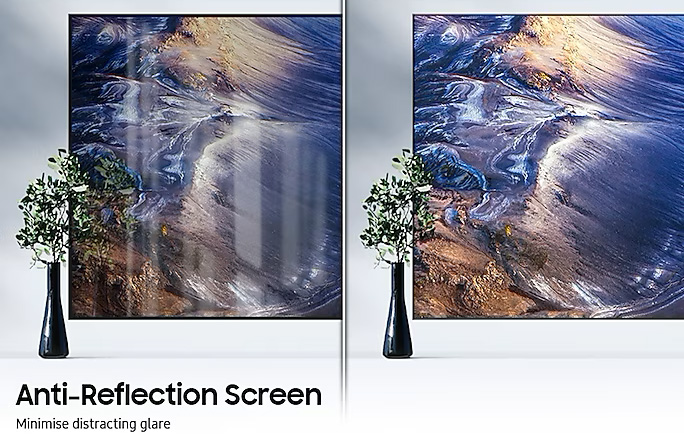
Final Thoughts
The 2022 QN95B was a very impressive TV by any standards. And it seems that Samsung used the time to make refinements in some much desired areas. The result is a TV that is not drastically different from its 2022 predecessor, but one that manages to distinguish itself enough to be considered a remarkable offering.
The QN95C has amazing performance. It has great colors, an improved backlight with local dimming, good accuracy, very little blooming, amazing brightness and is full of gaming features. The Tizen platform is as robust as it can be and offers all the smart functionality you could ask for.
On the downsides, low quality content could look better while the TV also displayed some stuttering with content we tried. Also with a flagship TV so full of features it is disappointing to see the QN95C not supporting Dolby Vision or DTS. There is no 55″ size in the US market. And lastly, there are other far cheaper options with very similar performance to this one. And this is something Samsung will have to seriously consider in the future.
We reached the end of our Samsung QN95C review and overall we can say that we are really impressed with what Samsung did this year. If they can lower the price a bit, it can really be a very competitive option in the 65″ flagship mini LED TV arena. And for that it deserves your consideration.

For more reviews you can check our dedicated 4K LED LCD TV reviews list or even look at our Product Reviews Table where you can find the brand and specific product you are looking for.
Cheapest Places to Buy :
*We are a reader-supported website. When you buy through links on our site, we may earn a small affiliate commission at no extra cost to you. Home Media Entertainment does not accept money for reviews.*





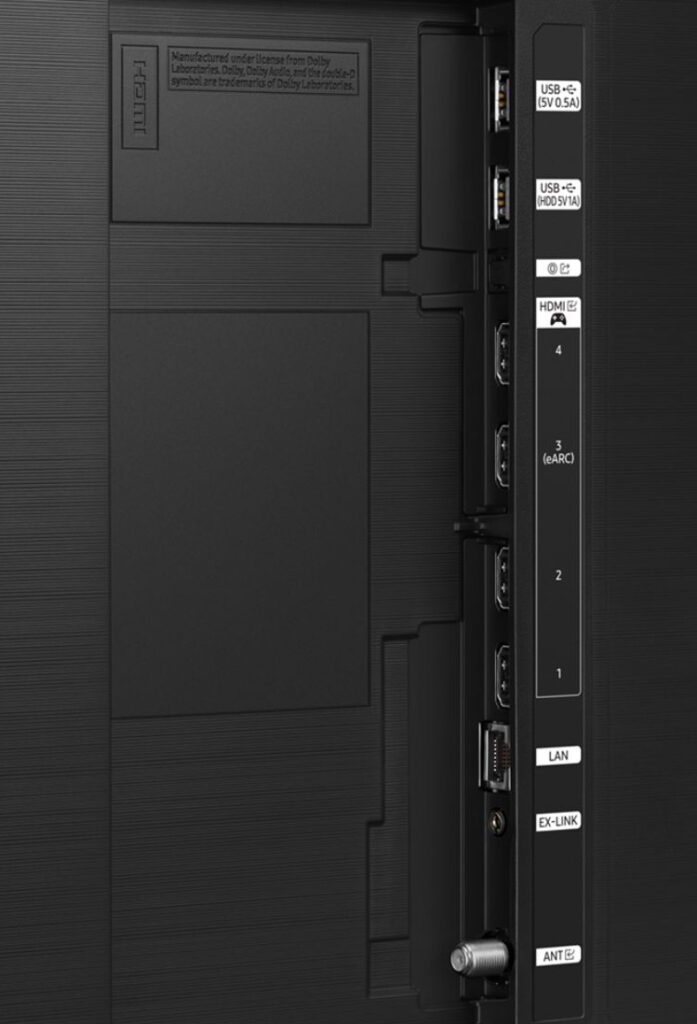
Samsung never disappoints in terms of quality and performance. It’s just that I never bought a Samsung TV in the past. I did buy a monitor back in 2015. However, I do have a question about the pricing. Is it worth the hefty price tag? Or I might as well get Sony since it’s been there since before I was even born.
Hello Raymond. Well, it depends. If you are talking about the Sony X95L then in terms of image quality the Sony has the upper hand. If you are more into gaming then probably the Samsung better suits you as it has more features.
One aspect I’m curious about is the TV’s performance in terms of energy efficiency. With the high brightness and advanced technology it boasts, how does the QN95C fare in terms of power consumption? Is it significantly more power-hungry compared to its predecessors or similar models in the market? This information could be really useful for those of us trying to be more energy-conscious in our choices.
Thanks for the great review!
Best regards,
Makhsud
Hey there. This depends a lot on the settings you will be using. From what I have seen its max consumption is higher than last year’s QN95B but its average consumption is lower. But as I said… there are many factors that can change that a lot.